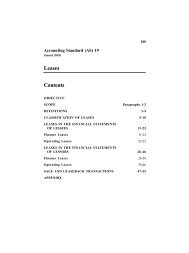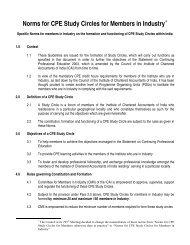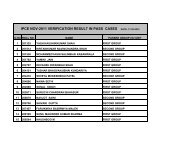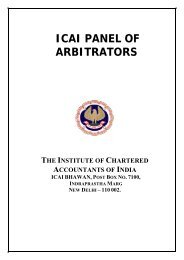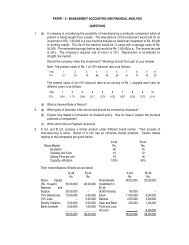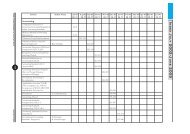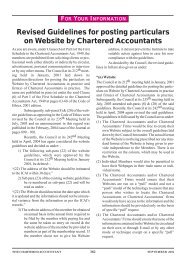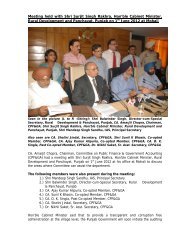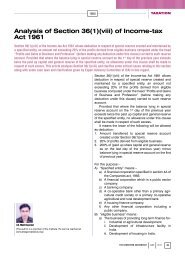The Chartered Accountant
The Chartered Accountant
The Chartered Accountant
Create successful ePaper yourself
Turn your PDF publications into a flip-book with our unique Google optimized e-Paper software.
AUDITING<br />
Pillar 3 of Basel II purports to enforce market discipline through stricter<br />
disclosure requirement. While admitting that such disclosure may be useful<br />
for supervisory authorities and rating agencies, the expertise and ability of<br />
the general public to comprehend and interpret disclosed information is<br />
open to question. Moreover, too much disclosure may cause information<br />
overload and may even damage financial position of bank.<br />
record. Basel II has introduced the concept of 5<br />
different risk weights - 20 per cent, 30 per cent,<br />
50 per cent, 100 per cent and 150 per cent. For<br />
the highest rated borrower, banks need to keep<br />
only 20 per cent of 8 per cent or 1.6 per cent (8x<br />
20 per cent) of the credit exposure as capital.<br />
<strong>The</strong> RBI has retained the higher base level of 9<br />
per cent against world level of 8 per cent. <strong>The</strong>se<br />
risk weights apply in tandem with credit rating<br />
given by our accredited rating agencies who decide<br />
the fate of the borrower. If a bank wishes<br />
to have pity on an unrated borrower, it can do so<br />
by keeping in more risk capital in its warehouse.<br />
l Basel I gave no weightage to availability of security<br />
for credit facility which has been given due<br />
consideration in the new accord.<br />
l Basel I prescription of allowing banks keep same<br />
risk capital irrespective of the maturity profile<br />
of the loan has been eroded by Basel II making<br />
some distinction between short and long-term<br />
loans given by banks.<br />
l Basel I encouraged regulatory arbitrage 2 by cherry<br />
picking which has been given no scope in Basel<br />
II.<br />
l <strong>The</strong> risk assessment specific to the bank, disclosures<br />
and reporting have been emphasized by<br />
Basel II accord through the Pillar 2 and Pillar 3.<br />
l <strong>The</strong> new dimension of operational risk which<br />
had gone unnoticed by Bank of International<br />
Settlements (BIS) earlier is now being given its<br />
due share of accreditation.<br />
As per the RBI guidelines, Indian banks having foreign<br />
branches and foreign banks operating in India had to<br />
adopt the regulations under Basel II by March 31, 2008.<br />
Except local area banks and regional rural banks, all the<br />
other commercial banks will have to migrate to Basel<br />
II by March 31, 2009. <strong>The</strong> Reserve Bank has adopted a<br />
three-track approach to capital adequacy regulation in<br />
India with the norms stipulated at varying degrees of<br />
stringency for different categories of banks given the<br />
variations in size, nature and complexity of operations<br />
and relevance of different types of banks to the Indian<br />
financial sector. Accordingly, commercial banks, which<br />
account for a major share in the total assets of the<br />
banking system and are Basel II standards compliant,<br />
would be on Track I, banks which are Basel I compliant<br />
would be on Track II and banks which are in the nature<br />
of local community banks would be on Track III. We<br />
are a quarter up in the financial year 2008, hence the<br />
pertinent questions to raise are-<br />
l Has over enthusiastic RBI which had been adamant<br />
on imposing rigorous Basel norms which<br />
by far exceed in severity than the ones prescribed<br />
by BIS actually succeeded?<br />
l Are our Indian banks actually ready to pose a<br />
threatening competition to the global banking<br />
giants?<br />
<strong>The</strong>re are too many questions to be raised but the answers<br />
are few.<br />
issues with implementation<br />
rising Cost Curve<br />
For Banks, the term ‘Non-Performing Assets’ rings an<br />
alarm bell. NPAs have largely been reduced by provisioning<br />
for bad debt or by infusion of capital from Government<br />
or other sources. But, with the implementation<br />
of Basel II norms, banks appetite for additional capital<br />
has increased and they are busy in arranging for capital<br />
outside of their own or the Government resources. In<br />
ICRA’s 3 estimates, Indian banks would need additional<br />
capital of up to Rs.120 billion to meet the capital requirement<br />
for operational risk. Looking at the asset growth<br />
witnessed in the past and the expected growth trend,<br />
the capital charge requirement 4for operational risk will<br />
grow by 15-20 per cent annually over three years.<br />
2Regulatory arbitrage is where a regulated institution takes advantage of the difference between its real (or economic) risk and the regulatory<br />
position. For example, if a bank, operating under the Basel I accord, has to hold 8% capital against default risk, but the real risk of<br />
default is lower, it is profitable to securitize the loan, removing the low risk loan from its portfolio. On the other hand, if the real risk is<br />
higher than the regulatory risk then it is profitable to make that loan and hold on to it, provided it is priced appropriately.<br />
3<br />
This estimate has been derived from ICRA 2005 report, analysis of which is based on banks financials till financial year end 2004-05.<br />
Hence, it would be advisable to take into account the surge in banks loan portfolios and credit growth post 2006 to revise this gross<br />
estimate upwards.<br />
4Capital charge for operational risk is equal to the average of 15% of annual positive gross income over the past three years, excluding<br />
any year when the gross income was negative. Gross income is defined as net interest income and non-interest income, grossed for any<br />
provisions, unpaid interest and operating expenses (such as fees for outsourced services). It should only exclude treasury gains/losses<br />
from banking book and other extraordinary and irregular income (such as income from insurance).<br />
THE CHARTERED ACCOUNTANT 979 DECEMBER 2008



